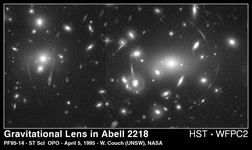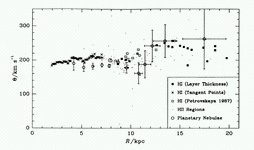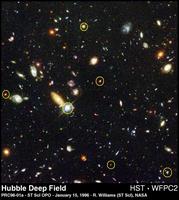You can't hide gravity
Since Newton's time, Astronomers have delighted in the powerful method
of finding new objects in space through the effects of their gravity, before
the objects themselves are actually seen directly. The first great success
of this idea was the discovery o f Neptune, by the
reconstruction of where it must be in the Solar Sytem in order
to gravitationally perturb the motions of the other planets. Similarly the
inference that some of the bright nearby stars must be circled by faint but
heavy companions lead to the discovery of white dwarf
stars.
The case of the missing matter
The
matter deepened in the 1970's and 1980's when it was discovered that the
motions of the stars
within individual galaxies were so rapid that they ought to fly apart,
too. If our understanding of Newtonian gravity is correct, then the implication
is that there is a lot of matter in these structures, holding them together,
but which we cannot yet see.
Blame it on the little guys
The most conventional idea for what these dark objects could be is in
faint red stars, stars
which are so intrinsically faint that they could not be detected directly
with our best telescopes until the launching of the
Hubble Space Telescope . Some such stars are known to exist,
since a few happen to be close to the Earth, but if th
e dark matter in the Galaxy were composed of such stars, the vast
majority would be so far from us that ground based telescopes are unable
to distinguish between these faint stars and the much more numerous faint
galaxies. These stars are red because they are smaller than the sun and
their surfaces are cooler. The superb resolving power of Space Telescope
allows us to get around this problem for the first time: with the ten times
sharper images we get from space, above the distortion of Earth's atmosphere,
the difference between faint stars and faint galaxies can be easily seen.
At Tuorla Observatory,
we have examined the images taken of the so-called
Hubble Deep Field, and saw far fewer faint stars than predicted
if the dark matter were made entirely of these objects. The Hubble Deep
Field is a one week long exposure taken with the Space Telescope of a small
patch of sky; it shows the faintest stars and galaxies
ever seen. Case dismissed!If the dark matter in our own Galaxy were composed of faint red stars, then we would expect to see dozens or even hundreds of them on this image, whereas we found no red stars at all. This puts a strict limit on the amount of dark matter which could be in faint objects of this type. This leaves the possibility that the dark matter is made of something fainter still, such as brown dwarfs, (basically big versions of Jupiter) which are not hot enough internally to begin nuclear fusion and so do not glow like true stars. Some of these long predicted objects have been actually located in just the last two years, but they would be too faint to see in this image. Then again, the dark matter may be something completely different, such as fundamental particles like the neutrino, or WIMPS, or axions or black holes (quite a list!); or we may even need to modify the laws of Gravity. All of these possibilities and more are in active research around the world.
|



|
